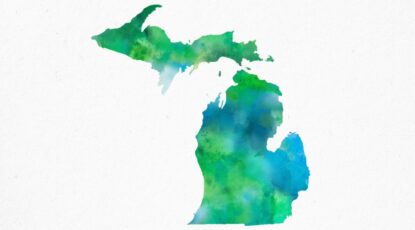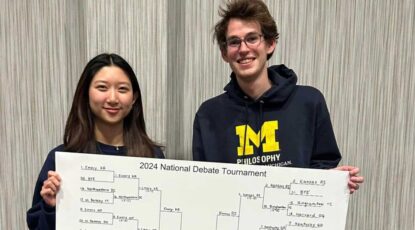Too much screen time? U-M pioneers digital wellness program for youths

Addiction, cyberbullying, eating disorders, anxiety, and other mental health issues caused by problematic digital practices and an increase in screen time are some of the themes of a new and unique U-M interprofessional Peer-to-Peer Digital Wellness class.
-
Look to Michigan: The ‘defining public university of the future
U-M’s strategic vision for the next decade leverages the community’s expertise and excellence — at scale — to impact the world’s greatest challenges. Read the report and listen to the podcast about ‘Vision: 2034.’
-
How does exposure to ‘forever chemicals’ impact your cancer risk
U-M investigators need your help to understand statewide environmental exposures and cancer risk. Researchers hope to recruit 100,000 Michiganders ages 18-49 from diverse racial and ethnic backgrounds, with a focus on residents in Metro Detroit, Flint, Grand Rapids, Kalamazoo, Lansing, and Saginaw.
-
Chemicals stored in home garages linked to ALS risk
Over the last decade, researchers at U-M have found exposure to environmental toxins — from pesticides used in agriculture to volatile organic compounds in the manufacturing industry — is linked to the development of amyotrophic lateral sclerosis, or ALS. The buildup of exposures is possibly associated with recreational activities such as woodworking and gardening.
-
How trauma gets ‘under the skin’
U-M researchers have found that people who experienced greater childhood adversity, reporting one or more traumatic or adverse events, had poorer muscle metabolism later in life. The researchers say the effects of childhood adverse events remained significant even after they controlled for other factors that could potentially impact muscle function such as age, gender, educational attainment, and more.
-
U-M debate team secures its first national title
After finishing runner-up seven times, the U-M debate team clinched its first national championship April 8. U-M Debate, which began in 1903, is one of the oldest debate programs in the United States. Debaters Kelly Phil and Bennett Dombcik won on a 5-0 decision against the University of Kansas in the 2024 tournament.
-
U-Michigan launches strategic vision, pledges to be ‘the defining public university’
After a year of gathering input from the campus community, the U-M administration has released its strategic vision for the next 10 years. Vision 2034 — detailed in an initial 43-page report — calls upon the University to leverage its interdisciplinarity and excellence at scale to educate learners, advance society, and make groundbreaking discoveries.
Columns
-
President's Message
From this day forward: ‘Vision 2034’
As U-M plans for the next decade, we prioritize the safety of our present-day campus community. -
Editor's Blog
Something old, something new
Who's ready for an excellent adventure? Just keep an eye peeled for the (virtual) hot lava. -
Climate Blue
Order from disorder
Ricky Rood explains the organizing principles behind weather, which is how we feel climate. -
Health Yourself
Getting a leg up on sciatica and piriformis syndrome
Victor Katch compares and contrasts sciatica and piriformis syndrome and explains how to ease that pain in your butt.
The Art Show
Founded in 1990 with a single theatre workshop, the Prison Creative Arts Project (PCAP) is a program of U-M’s Residential College. Courses serve as gateways for undergraduate participation in prison arts workshops and provide academic training in issues surrounding incarceration and practical skills in the arts. The program’s Annual Exhibition of Artists in Michigan Prisons (“the art show”) is one of the largest exhibits of artwork by incarcerated artists in the world. The annual exhibition, free to the public, is presented with support from the Michigan Arts and Culture Council. It runs through April 2 at the Duderstadt Gallery. (Click on the images to enlarge. Images are courtesy of PCAP.) Learn more about PCAP.



















